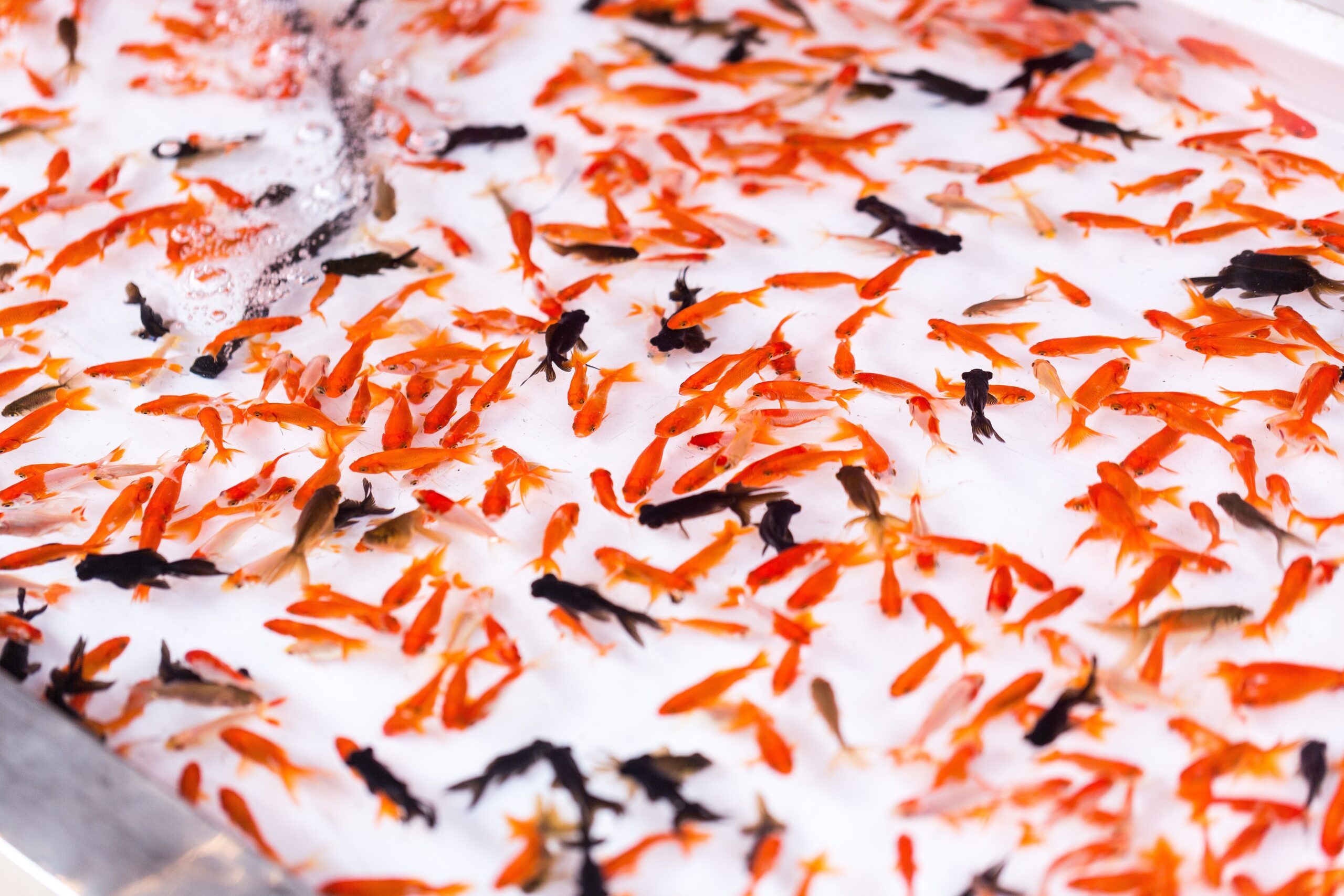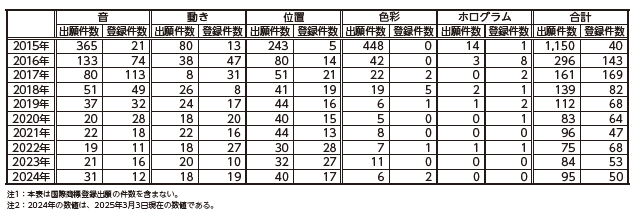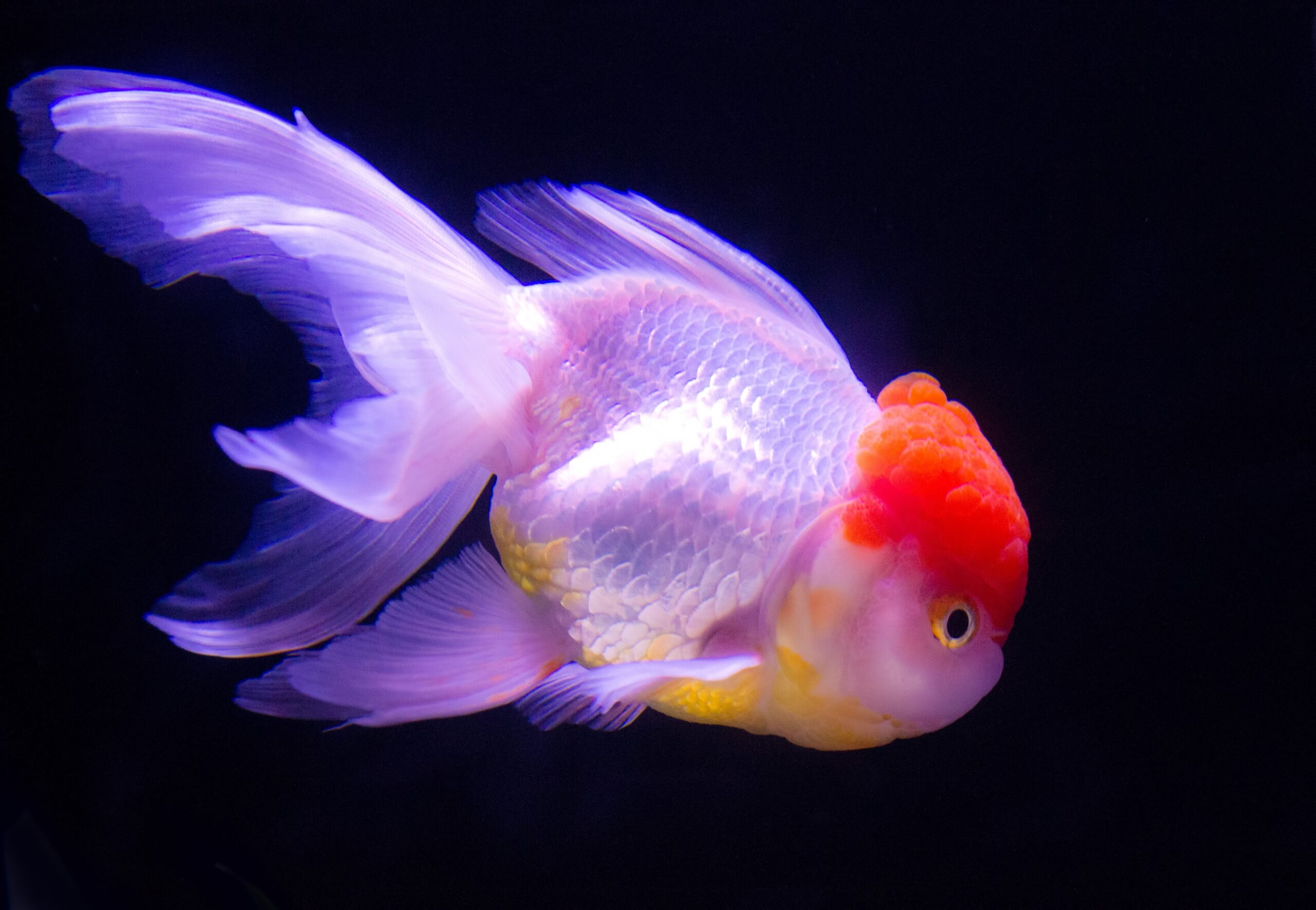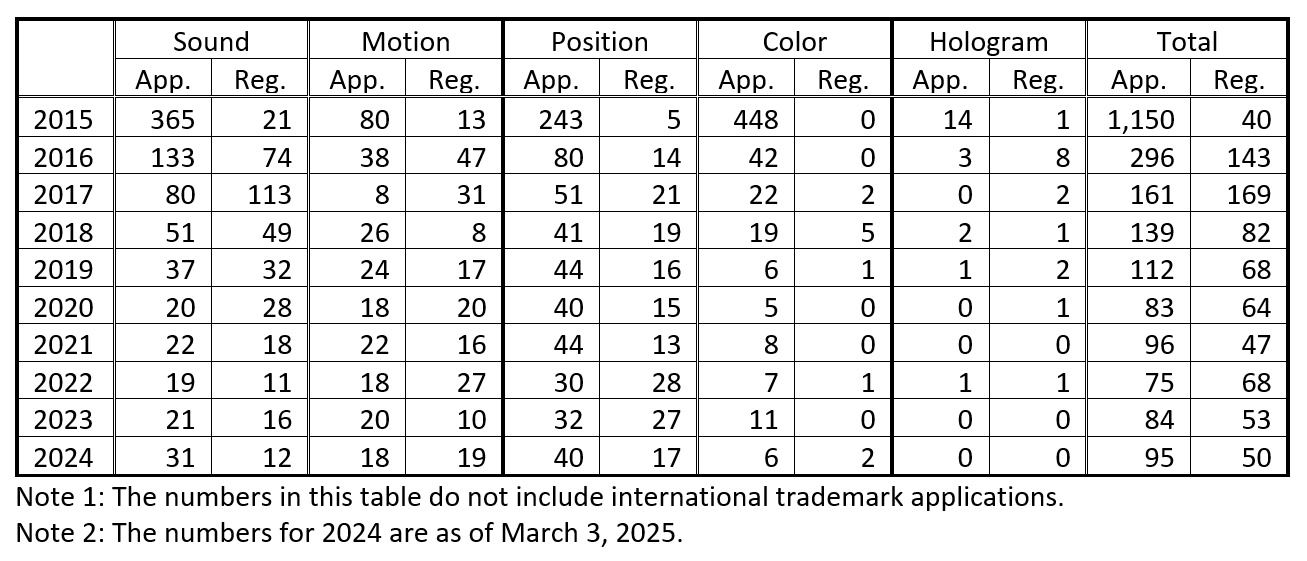目次
8月号【法務】ニュースレター

「新しいタイプの商標」の出願・登録件数の推移
日本において新しいタイプの商標(音商標、動き商標、位置商標、色彩のみからなる商標、ホログラム商標)の登録制度が始まってから、2024年で10年が経過しました。 「特許行政年次報告書2025年版」において、制度が始まった2015年から2024年までの10年間における各商標類型別の出願・登録件数がまとめられていますので、ご紹介します。

制度が始まった2015年には、色彩のみからなる商標の出願件数が448件と最も多く、次いで音商標が365件、位置商標が243件、動き商標が80件、ホログラム商標が14件出願されました。いずれの類型においても、制度開始年である2015年の出願件数が最も多く、翌2016年には半数以下に減少しています。特に色彩のみからなる商標については、制度開始時には最も出願件数が多かったものの、2016年には42件まで減少し、2019年以降はほぼ1桁台となっています。
登録件数については、音商標と位置商標では2017年が10年間で最も多く、動き商標とホログラム商標では2016年が最も多くなっています。また、色彩のみからなる商標については、2015年・2016年には登録件がなく、2017年に初めて登録が行われました。
10年間の全体の登録件数を見てみると、音商標が出願779件に対し登録374件(10年登録率約48%)、位置商標が出願645件に対し登録175件(同約27%)、動き商標が登録272件に対し登録208件(同約76%)、ホログラム商標が出願21件に対し登録16件(同約76%)である一方、色彩のみからなる商標は出願574件に対し登録11件(同約2%)と、圧倒的に登録件数の割合が低くなっています。色彩のみからなる商標は原則として識別力を有さないとされているため、登録するには使用によって識別力を獲得したことを証明する必要があります。登録件数の少なさから、色彩のみからなる商標を登録する際のハードルの高さがうかがえます。
新しいタイプの商標全体の2024年の出願件数は95件、登録件数は50件という数字を見ると、これらの商標類型の出願および登録件数は多いとは言い難く、当該登録制度の活用は限定的であると言えるでしょう。その背景には、従来の文字や図形の商標登録とは異なる登録要件や、それに伴う拒絶理由対応の難しさがあるものと考えられます。
しかしながら、新しいタイプの商標には多様な媒体において消費者に強い印象を与える可能性があります。これらの商標の登録が進み、登録商標としての活用が広がることで、企業のブランド構築において戦略的な役割を担うことが期待されます。
「特許行政年次報告書2025年版」(特許庁)
https://www.jpo.go.jp/resources/report/nenji/2025/index.html
(2025年7月10日 一部当所にて抜粋して利用)
特許庁「政府模倣品・海賊版対策総合窓口年次報告書 2025年版」を作成・公表
2025年7月7日、特許庁国際協力課海外展開支援室(政府模倣品・海賊版対策総合窓口)は、「政府模倣品・海賊版対策総合窓口年次報告書 2025年版」を公表した。同報告書は、「知的財産推進計画2005」(知的財産戦略本部決定)に基づき、2024年の相談受付業務等の内容を「年次報告書」としてとりまとめたものである。
報告書の概要は以下の通りである。
■相談・情報提供の受付の概況
- 2024年の受付件数の総数は1,007件。電子メールでの受付が多く86.6%。
- 2024年の受付件数のうち、情報提供は798件、相談件数は209件。
- インターネット取引関連の相談・情報提供は、項目ベースで802件。
- 情報提供としては、フリマアプリや詐欺的なSNS広告を介した模倣品販売に関するものが多い。
- 相談としては、国外事案を含む権利行使方法等に関する法的な問題の確認、輸入差止申立て等の申請先、無料相談が可能な専門機関の紹介依頼が多い。
■相談受付の内訳(被害発生国・地域別、商品分野別)
- 2024年の相談案件のうち、製造(発生)国・地域が判明しているものは、項目ベースで日本・中国が同率で多い。
- 2024年の相談案件のうち、商品の種別が明らかなものは、項目ベースで一般機械・産業機械、繊維の順に多い。
■相談・情報提供の受付の内訳(知的財産権・関連法令別)
- 2024年の相談案件のうち、対象となる知的財産権の内容が明らかなものは、項目ベースで商標権、著作権の順に多い。
- 2024年の情報提供案件のうち、対象となる権利の内容が明らかなものは、項目ベースで著作権、商標権の順に多い。
[参考]文化庁における取組
文化庁においても、関係省庁・関係団体等と連携をとりながら海外における海賊版対策等著作権の保護に取り組んでおり、「インターネット上の著作権侵害(海賊版)対策ハンドブック」を公表している。同ハンドブックの総論編では、国を意識しない「共通の対応」などについて整理すると共に、国内における「共通の対応」を実施しても奏功しない場合、各国の法制度に基づいた侵害対応実務等を行う必要があることから、各論編において各国ごとに具体的な法制度及びそれに基づく権利行使等を調査し、取りまとめている。
<参考URL>
特許庁「政府模倣品・海賊版対策総合窓口年次報告書 2025年版」
https://www.jpo.go.jp/resources/report/mohohin/document/nenji/nenjihoukokugaiou2025.pdf
文化庁「インターネット上の著作権侵害(海賊版)対策ハンドブック」
https://www.bunka.go.jp/seisaku/chosakuken/kaizokuban/handbook/seminar.html
「生成AI技術の発達を踏まえた意匠制度について」 第20回意匠制度小委員会配布資料から
当所のニュースレターでは、特許庁主催の意匠制度⼩委員会における検討課題について、特に、「仮想空間におけるデザインと意匠制度」について紹介してきた。
今回は、令和7年6月30日に開催された第20回意匠制度⼩委員会にて配布された資料から、「生成AI技術の発達と意匠制度」についての検討課題を紹介する。本資料から、意匠制度が今後、どのような方向性で改正を検討されているか知ることができる。(以下、「第20回意匠制度小委員会 配布資料1(特許庁)から抜粋)
①意匠、②創作者、③引用意匠適格性、④新規性喪失の例外、⑤創作非容易性、及び、⑥記載要件という6つの論点のうち、①~④の4つの論点について、本資料に基づき、今後の検討の方向性が整理されたようだ。検討の結果については、追って取り上げていく予定だ。
①意匠について
<今後の検討の方向性>
生成AIを利用して作成したデザインのうち、(少なくとも)人が創作に実質的に関与したものについては、「法上の意匠」に該当し得る、という方向性で検討を進めてはどうか。
<留意事項>
生成AIを利用して作成したデザインのうち、人が創作に実質的に関与していないもの(AI自律デザインを含む)が、「法上の意匠」に該当し得るかについても、引き続き検討をする。
※「AI自律デザイン」とは、生成AIを利用して作成したデザインのうち、(人が創作に関与しておらず)生成AIが自律的に作成したデザインをいうものとする。
②創作者について
<今後の検討の方向性>
生成AIを利用して作成したデザインについて、創作者に関する従前の考え方を適用した場合、誰がどのような場合に創作者となり得るか、整理してはどうか。
また、AI自律デザインについて、生成AIを創作者としては認めないという方向性で検討を進めてはどうか。
<留意事項>
AI自律デザインについて、生成AIを創作者としては認めない場合、特定の自然人を創作者であると偽って出願する可能性が生じること(いわゆる「僭称問題」)等
③引用意匠適格性について
<今後の検討の方向性>
比較的容易に低コストで大量に生成できる生成AIを利用したデザインを、新規性・創作容易性に係る拒絶理由の引例とした場合に、登録要件である新規性・創作容易性の在り方にどのような影響を与えるかをより分析してはどうか。
生成AIを利用して創作されたものか、事後的に判別することは困難なため、生成AIを利用したか否かを直接的に要件や基準とはしない対応を検討すべきではないか。
④新規性喪失の例外について
<今後の検討の方向性>
出願前に出願人の既存デザインに基づき、第三者が生成AIを利用するなどして作成・公開された場合、新規性喪失例外の適用対象となるか、仮に適用対象とならない場合に何らかの対応をすべきか、引き続き検討してはどうか。
URL:https://www.jpo.go.jp/resources/shingikai/sangyo-kouzou/shousai/isho_shoi/document/20-shiryou/03_shiryo-1.pdf
(2025年7月11日に利用)
※P27からP46をもとに当所にて加工して作成
Newsletter translated into English

Trends in the Filing and Registration of “New Types of Trademarks”
As of 2024, ten years have passed since Japan introduced a registration system for “new types of trademarks,” which include sound marks, motion marks, position marks, color marks (composed solely of colors), and hologram marks. The “Annual Report on Patent Administration 2025 Edition” summarizes the application and registration numbers for each type of trademark over the ten years from 2015, when the system began, to 2024. Below is an overview.

(The above table is a translation of a table found on p.101 of the Annual Report on Patent Administration 2025 Edition).
In 2015, the first year of the system’s implementation, the number of applications for color marks was the highest, at 448 applications, followed by sound marks with 365 applications, position marks with 243 applications, motion marks with 80 applications, and hologram marks with 14 applications. Across all categories, the application numbers peaked in 2015, the year the system was introduced, and subsequently dropped by more than half in 2016. Notably, applications for color marks, despite their initial prominence, decreased sharply to 42 applications in 2016, and have remained in single digits since 2019.
Regarding registrations, sound marks and position marks saw their highest numbers in 2017, whereas motion marks and hologram marks reached their peak in 2016. For color marks, there were no registrations in 2015 or 2016, with the first registration occurring in 2017.
Looking at the overall registration numbers over the past decade, there were 779 applications for sound marks, of which 374 were registered (a ten-year registration rate of approximately 48%). There were 645 applications for position marks, with 175 registrations (about 27%), 272 applications for motion marks, with 208 registrations (around 76%), and 21 application for hologram marks, with 16 registrations (approximately 76%). In contrast, there were 574 applications for color marks, but only 11 registrations (a mere 2%). The notably low registration rate for color marks reflects the inherent difficulty in securing their registration. As a general rule, color marks are not considered inherently distinctive, meaning applicants must demonstrate acquired distinctiveness through usage to achieve registration. The low number of registrations underscores the high hurdles involved in registering color marks.
In 2024, there were 95 total applications for all new types of trademarks, with 50 registrations. These figures suggest that the application and registration activity for these trademark categories remains relatively limited, indicating restricted utilization of the registration system. This limited usage may be attributed to the unique registration requirements and the associated challenges in addressing grounds for refusal, which differ from those for traditional word and design trademarks.
Nonetheless, new types of trademarks have the potential to leave a strong impression on consumers across diverse media platforms. As registrations for these trademarks progress and their utilization as registered marks expands, they are expected to play a strategic role in corporate brand building.
“Annual Report on Patent Administration 2025 Edition” (Japan Patent Office)
https://www.jpo.go.jp/resources/report/nenji/2025/index.html
(Used in part by our office on July 10, 2025)
Publication of the Japan Patent Office’s “Counterfeit and Piracy Countermeasure Comprehensive Contact Point Annual Report 2025 Edition”
On July 7, 2025, the Overseas Expansion Support Section (Counterfeit and Piracy Countermeasure Comprehensive Contact Point) of the Japan Patent Office (JPO)’s International Cooperation Division released the Counterfeit and Piracy Countermeasure Comprehensive Contact Point Annual Report 2025 Edition. This report consolidates the activities of consultation services and related operations conducted in 2024 into an annual report, based on the “Intellectual Property Promotion Plan 2005” (as determined by the Intellectual Property Strategy Headquarters).
Below is an outline of the report:
■ Overview of Consultation and Information Provision Services
- In 2024, a total of 1,007 cases were received, with 86.6% of submissions made via email.
- Of the above total, 798 cases involved information provision, while 209 cases were consultations.
- 802 cases involved issues related to internet transactions (item-based count).
- A significant proportion of information provision cases concerned counterfeit product sales through flea market apps and fraudulent advertisements on social media platforms.
- Common consultation topics included legal issues related to exercising rights (including cases overseas), inquiries about filing applications for import suspension measures, and requests for referrals to specialized agencies offering free consultations.
■ Breakdown of Consultation Cases by Country/Region of Origin and Product Category
- Among consultation cases in 2024 for which the manufacturing (origin) country or region was identified, Japan and China were equally the most frequently mentioned (item-based count).
- Among consultation cases in 2024 for which the type of product was identified, general machinery and industrial machinery ranked highest, followed by textiles (item-based count).
■ Breakdown of Consultation and Information Provision Cases by Intellectual Property Right and Related Legal Provisions
- Among consultation cases in 2024 for which the types of intellectual property rights involved were identified, trademark rights ranked highest, followed by copyrights (item-based count).
- Among information provision cases in 2024 for which the types of rights involved were identified, copyrights ranked highest, followed by trademark rights (item-based count).
[Reference] Efforts by the Agency for Cultural Affairs
The Agency for Cultural Affairs, in collaboration with other governmental agencies and related organizations, is also actively working to protect copyrights overseas and combat piracy. As part of these efforts, the agency has published the Handbook for Countermeasures Against Copyright Infringement (Piracy) on the Internet.
The General Explanations section of the handbook organizes “common approaches” that are not country-specific. In cases where such common approaches within Japan prove ineffective, it highlights the need for practical measures based on each country’s legal system. Accordingly, the Detailed Explanations section of the handbook investigates and summarizes specific legal systems of individual countries and the corresponding practices for exercising rights under those systems.
• Japan Patent Office: Counterfeit and Piracy Countermeasure Comprehensive Contact Point Annual Report 2025 Edition
https://www.jpo.go.jp/resources/report/mohohin/document/nenji/nenjihoukokugaiou2025.pdf
• Agency for Cultural Affairs: Handbook for Countermeasures Against Copyright Infringement (Piracy) on the Internet
https://www.bunka.go.jp/seisaku/chosakuken/kaizokuban/handbook/seminar.html
“The Design System in Light of Advances in Generative AI Technology” – from Materials Distributed at the 20th Design System Subcommittee
In previous newsletters, our office has highlighted key issues deliberated by the Design System Subcommittee organized by the Japan Patent Office (JPO), with particular focus on topics such as “Designs in Virtual Spaces and the Design System.” This time, we will introduce the topic of “Advances in Generative AI Technology and the Design System,” based on materials distributed at the 20th Design System Subcommittee held on June 30, 2025. The materials provide insights into potential directions for future amendments to the Design System. (The following is an excerpt from Document 1 of materials distributed at the 20th Design System Subcommittee (JPO)).
Among the six identified points of discussion—(1) design, (2) creator, (3) eligibility of cited designs, (4) exceptions to loss of novelty, (5) non-obviousness, and (6) description requirements—the deliberations outlined in the materials primarily address the first four points (1–4). The findings of these discussions will be reported in future updates.
(1) Regarding Designs
Direction for Future Deliberation
For designs created using generative AI, the proposal is to consider that designs where (at least) humans have substantively contributed to the creative process may qualify as “statutory designs” under the law.
Points to Note
Further deliberation is required regarding whether designs created using generative AI without substantive human involvement (including autonomous AI-generated designs) may qualify as “statutory designs” under the law. Note: “autonomous AI-generated designs” refers to designs created using generative AI that are autonomously generated without human involvement in the creative process.
(2) Regarding the Creator
Direction for Future Deliberation
For designs created using generative AI, the deliberation involves organizing the criteria under which someone may be considered a creator, based on traditional concepts of authorship.
Additionally, it is proposed to proceed with the deliberation on the premise that autonomous AI-generated designs should not recognize generative AI as the creator.
Points to Note
If generative AI is not recognized as the creator for autonomous AI-generated designs, there is a risk of issues such as individuals falsely claiming to be the creator when filing applications (commonly referred to as “misrepresentation problems”).
(3) Regarding Eligibility of Cited Designs
Direction for Future Deliberation
When designs created using generative AI, which can be generated relatively easily and at low cost in large quantities, are used as prior art in novelty and non-obviousness rejections, further analysis is required to evaluate the impact on the criteria for registration (novelty and non-obviousness).
Since it is challenging to retrospectively determine whether generative AI was utilized in the creation process, it is proposed not to directly incorporate the use of generative AI as part of the requirements or standards for eligibility.
(4) Regarding Exceptions to Loss of Novelty
Direction for Future Deliberation
In cases where a third party uses generative AI to create and publicly disclose designs based on the applicant’s existing designs prior to the filing of an application, deliberation is ongoing regarding whether such scenarios should fall under the scope of exceptions to loss of novelty. If not, further consideration is required on possible measures to address these situations.
“Discussion Points on the Design System” (Japan Patent Office)
https://www.jpo.go.jp/resources/shingikai/sangyo-kouzou/shousai/isho_shoi/document/20-shiryou/03_shiryo-1.pdf
(Accessed July 11, 2025)
This article was prepared by our office based on pages 27–46 of the above document.
